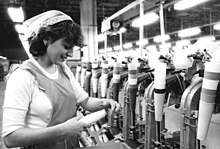Eichsfeld plan
The Eichsfeld Plan was a development plan of the SED for the Eichsfeld in the north of Thuringia , which was adopted at its fifth party congress in 1958.
Historical background
In the 1950s, Eichsfeld was a Catholic, little industrialized, impoverished region in the direct border area with West Germany, which was cut off from the nearby cities of Kassel and Göttingen by the inner German border . As a result, it was feared that the people might rebel against the rulers in the GDR. In order to forestall this, the Eichsfeld should be "proletarianized" through industrialization and the influx of people from other parts of the GDR. The Catholic milieu was to be broken through the expansion of the social, cultural and economic infrastructure.
After the course for the Eichsfeld plan had been set at the fifth party congress of the SED in 1958, on May 14, 1959 the SED district leadership in Erfurt adopted the plan for the industrial and cultural development of the Eichsfeld .
implementation
The village of Leinefelde was chosen as the future industrial center . It was sufficiently far from the inner-German border and offered acceptable terrain conditions in the mountainous region as well as a good rail connection to Halle and Erfurt . In 1961 the cotton spinning mill was founded in Leinefelde and employed 4,000 people. It processed Russian cotton from Central Asia and manufactured the majority of the yarns and threads processed in the GDR. A new residential area was built in Leinefelde for the 4,000 employees. The village grew from about 2500 inhabitants after the Second World War to 16,000 inhabitants before reunification. In 1969 Leinefelde received city rights on the occasion of the 20th anniversary of the GDR. The city remained the only socialist city in the Erfurt district .
Further expanded industrial operations in the Obereichsfeld were the potash works in Bischofferode , which became known after the fall of the Wall , the Solidor Heiligenstadt combine and the newly built cement factory in Deuna . In addition, there were cultural institutions such as the district culture house in Heiligenstadt and the current Obereichsfeldhalle in Leinefelde.
literature
- Petra Behrens: Regional Identity and Regional Culture in Democracy and Dictatorship. Home propaganda, regional cultural activities and the construction of the Eichsfeld region between 1918 and 1961 (Historical Foundations of Modernism; Vol. 6). Nomos VG, Baden-Baden 2012, ISBN 978-3-8329-7655-2 (also dissertation, University of Hannover 2010). In it especially chapter 5.6: The Eichsfeld Plan as a means of socialist restructuring of the region , pp. 232–241.
- Christian Stöber: “Drawing lessons, gaining experience and creating an example for the construction of socialism” - SED rule in the 1950s and the emergence of the Eichsfeld Plan . In: Eichsfeld-Jahrbuch, vol. 22 (2014), pp. 281–312.
- Christian Stöber: Rosary Communism. The SED dictatorship and the Catholic milieu in Eichsfeld 1945 - 1989 , Ch. Links Verlag , Berlin 2019.
- Edited by the Worbis district council: Eichsfeldplan: Action plan for the further cultural development of the Worbis district until 1960. Worbis 1959 + supplement
swell
- Lutz Heydick u. a. (Ed.): Historischer Führer. Districts of Erfurt, Gera, Suhl . Urania-Verlag, Leipzig 1977, ISBN 3-332-00186-8 , p. 76.
Individual evidence
- ↑ Christian Stöber: "Drawing lessons, gathering experience and creating an example for the construction of socialism" - SED rule in the 1950s and the emergence of the Eichsfeld Plan. in: Eichsfeld-Jahrbuch 2014, 22nd year, Mecke Verlag Duderstadt
- ↑ Adelheid von Saldern: Staged unity: Presentation of power in GDR cities. Franz Steiner Verlag Stuttgart 2003, page 240 (source: ThHStA Weimar, BPA SED EF / Kl WBS 4.13-050, decision of the office of the district management dated May 14, 1959)

